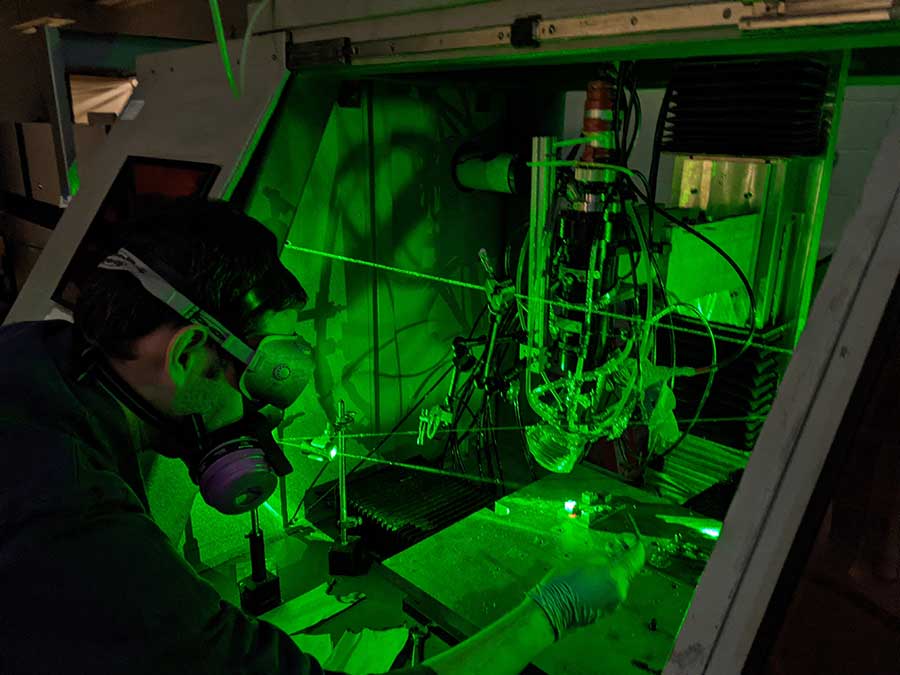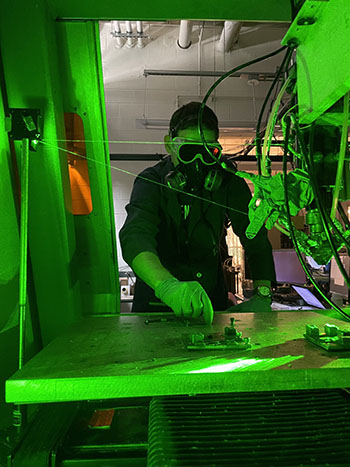

 Metin Kayitmazbatir working on the DMD technology in Jyoti Mazumder's lab.
Metin Kayitmazbatir working on the DMD technology in Jyoti Mazumder's lab.
The use of renewable wind energy is increasing globally, and wind turbine blades are a key enabler of clean energies, namely wind energy technologies. Hollow and typically formed with composites, such as polymer-based and reinforced glass fibers, the blades’ length determines its power output; the longer the blade, the more energy generated. The 108-meter (approximately 328 feet) IntegralBlade® made by Siemens Gamesa is currently the longest in production and can produce about 14 megawatts of electricity per year. One megawatt of electrical energy is enough to power 225 to 300 typical American homes.
But as blade length grows, tooling and manufacturing challenges increase as well. Blades over 90 meters require extremely large molds in which to cast them, and the process of casting, cutting, and polishing the mold to ensure a smooth blade surface are expensive, space- and time-intensive, and generate almost 50% waste material through cutting processes. Quality inspections of finished blades currently happen once the blade is finished, so issues detected mean expensive rework and further waste. As a result, today’s manufacturing practices, as well as transportation logistics, limit blade length, and monolithic solutions are not possible for blades longer than 120 meters.
“There’s a critical need to reduce the obstacles and costs of mold tooling for longer blades, especially those over 120 meters—without compromising blade quality,” said Miki Banu, ME research professor who, along with ME Professor Kazu Saitou is leading a research team to develop a solution.
The industry-university collaboration also includes Pennsylvania State University; one of the largest U.S. wind blade manufacturers, TPI Composites; and aerospace component manufacturer Raytheon Technologies. The $3.4 million project recently was awarded funding from the U. S. Department of Energy Office of Energy Efficiency and Renewable Energy.
The team’s proposal, also initially co-led by the late ME Professor Jyoti Mazumder, aims to use technology pioneered by Professor Mazumder, direct metal deposition (DMD), a high-throughput additive manufacturing technology for developing modular or reconfigurable molds. Based on Professor Banu’s idea, these modules would fit together much like Lego™ blocks and enable a family of horizontal-axis wind turbines between 90 and 150 meters in length.
This additive manufacturing technology offers a high deposition speed and the potential for excellent heat management. DMD is among very few additive manufacturing technologies that can successfully print large metal parts using embedded “certify as you build” validation methods, a key component for printing large and complex parts.
The DMD process also allows for conformal channels within the molds, which will be printed using aerospace grade aluminum (Al) alloys. Channels within the mold structure will be optimized and can be used to cool the composite material once deposited and to heat it during the subsequent curing, or hardening, process.
The blade sections would then be removed from the mold modules and rapidly assembled with nearly seamless connections. This is possible due to another innovation the team has proposed: use of high-precision mating surfaces and dowel joints to ensure a smooth, aerodynamic blade surface.
During the DMD process, an optical feedback system developed and patented by Mazumder will enable continuous control of the mold microstructure, chemical composition and finished properties as well as real-time quality assessment. The system helps eliminate defects, including those due to metal shrinkage during cooling and reduces post-finishing operations.
 Metin Kayitmazbatir working on the DMD technology in Jyoti Mazumder's lab.
Metin Kayitmazbatir working on the DMD technology in Jyoti Mazumder's lab.
“The solution we’re developing addresses many of the challenges to current wind turbine blade tooling and casting, as well as transportation,” Banu said. “These innovations, when combined, can deliver tremendous costs saving and cut down process time.”
Today, shorter blades can take up to eight months to manufacture. Investigators estimate that the proposed paradigm and process will reduce the manufacturing time for molds by about 30%.
The use of aluminum alloys rather than steel, which current solutions rely on, will confer a hefty advantage in weight reduction, which also impacts transportation costs and logistics. “When we talk about transporting and storing the molds, lightweight is extremely important,” Banu said.
And while aluminum is more expensive than steel, the proposed approach requires less material due to the channels within the mold structure. The team estimates a weight reduction by 25% by using optimized conformal channels.
Given the molds’ modularity, they can be used and re-used in multiple configurations, customized for particular locations, or re-machined and used for additional blade types. “The modularity of our proposed solution brings a new level of flexibility to blade tooling, production and use,” Banu said.
The team’s modular tooling solution, a robot-based additive manufacturing technology, could be extended to other applications, including aviation and aerospace.
Additional U-M researchers include co-investigators Alan Taub, a professor in ME and Materials Science and Engineering, Theodor Freiheit, a research associate professor in ME and Daniel Cooper, ME assistant professor.
“Having an industry-university partnership like this one is critical to speeding the process of technological innovation to industry adoption and deployment,” Banu said, “and at the same time contributing to advancing clean energy production, with the ultimate goal to ‘make the world work better.’”